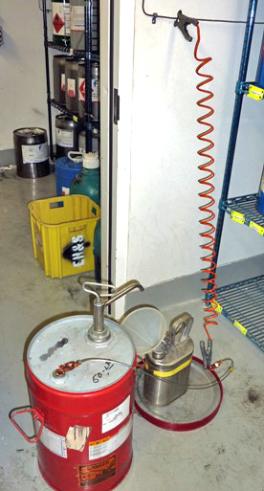Bonding and grounding is the process of providing an electrically conductive pathway between a dispensing container, a receiving container, and a ground. The process helps eliminate the buildup of static electricity and a possible spark that can cause a flash fire if there is a flammable mixture of fuel and air.
Both the National Fire Protection Association (NFPA) and the Occupational Safety and Health Administration (OSHA) have bonding requirements for flammable liquids
Requirement
Category 1 or 2 flammable liquids, or Category 3 flammable liquids with a flashpoint below 100 °F (37.8 °C), shall not be dispensed into containers unless the nozzle and container are electrically interconnected. Where the metallic floorplate on which the container stands while filling is electrically connected to the fill stem or where the fill stem is bonded to the container during filling operations by means of a bond wire, the provisions of this section shall be deemed to have been complied with. (29CFR 1910.106(h)(7)(i)(b))
Static electric discharge- release of static electricity in the form of a spark, corona discharge, brush discharge, or propagating brush discharge that might be capable of causing ignition under appropriate circumstances [NFPA 77 3.1.16].
The transfer of material to/from a metal container can result in an accumulation of static charge on the container. When transferring flammable liquids, this static charge could generate a spark, thereby igniting the liquid. To make these transfers safer, flammable liquid dispensing and receiving containers should be bonded together before pouring.
Large containers such as drums must also be grounded when used as dispensing or receiving vessels. All grounding and bonding connections must be metal to metal.
This means all containers of Category 1, 2 or 3 liquids (liquids with a flashpoint lower than 100° F) need to be bonded and grounded during dispensing. This includes non-metallic containers, even though the construction material may not be recognized as conductive (for example, polyethylene). If the containers are not properly bonded and grounded, the resulting static spark could be capable of raising the vapor temperature above the flashpoint, causing an explosion.
Common examples of Category 1 liquids include acetaldehyde and ethyl ether.
Examples of Category 2 liquids are acetone, benzene, and toluene.
Styrene and turpentine (mineral spirits) are examples of Category 3 liquids.
The flashpoint for a chemical can be found in section nine of the safety data sheet (SDS).
How to Bond and Ground
Transfer flammable liquids within a chemical fume hood when possible and in a proper dispensing location such as a well-ventilated laboratory.
Gather proper bonding and grounding cables- CBC supplies braided 3’ bonding cables with clips on each end and braided 5’ bonding cables with clips on each end.
In CBEC, a majority of CBC flammable cabinets are connected to an earth ground.
- Remove any paint, dirt, or debris to ensure a metal-to-metal connection any painted metal from the flammable cabinet, metallic floorplate, etc.
- Connect the dispensing vessel to the flammable cabinet that is grounded.
- Place the receiving container in a secondary container or bonding metallic floorplate.
- Connect the bonding cable from the receiving vessel to the dispensing vessel or floorplate.
- Discharge yourself by touching the ground after making connections and before starting any transfers.
- Once everything is properly connected, proceed with transferring the flammable material.

Definitions
Bonding- process of connecting 2 or more conductive objects together by means of a conductor so that they are at the same electrical potential, but not necessarily at the same potential as the earth [NFPA 77]
Grounding- is the process of bonding 1 or more conductive objects to the ground, so that all objects are at zero (0) electrical potential; also referred to as "earthing" [NFPA 77 - 3.1.10].
Grounding plate- metal plate used to provide a bond for the receiving container.
Grounding rod- easily cleaned non-reactive metal rod designed to provide a bonding point for containers.
Adapted from UCSD Grounding and Bonding
